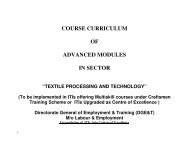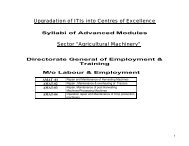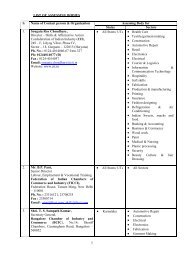Population Education In Vocational Training Programme
Population Education In Vocational Training Programme
Population Education In Vocational Training Programme
You also want an ePaper? Increase the reach of your titles
YUMPU automatically turns print PDFs into web optimized ePapers that Google loves.
c. Explain to the trainees that -<br />
One cannot get HIV/AIDS infection by -<br />
• Living with HIV infected patient.<br />
• Sharing bathroom or towels.<br />
• Sharing toilets.<br />
• Shaking or holding hands.<br />
• Common flies, mosquitoes, rats, cats, dogs etc.<br />
• Hugging and kissing.<br />
• Coughing and sneezing.<br />
Note: You may also use the Figures given in Annexure-10E to explain the information<br />
given in the box above.<br />
d. Further explain to the trainees that -<br />
HIV/AIDS -<br />
• Has no symptoms of its own.<br />
• Becomes visible in the form of symptoms of common diseases like diarrhea,<br />
fever, oral and genital infections, TB etc.<br />
• Presence of symptoms of more than one common disease and their persistence<br />
for a long period indicates the presence of AIDS.<br />
Step-7 Explain to the trainees that -<br />
• AIDS is also classified as one of the sexually transmitted disease.<br />
• There are other Sexually Transmitted Diseases (STDs) also like Gonorrhoea,<br />
Syphilis, Herpes, Chlamydia etc.<br />
• Some common symptoms of STDs are:<br />
- Yellow/green discharge;<br />
- Pain/burning sensation while urinating;<br />
- Small painless ulcer at the site of infection, usually around the sex organs or<br />
the mouth followed by red rashes all over the body;<br />
- Small painless ulcers on or around genital organs;<br />
- Small blisters on mouth or genital organs, accompanied by fever and general<br />
aches or pains; and<br />
- Warts on and around sex organs.<br />
• Persons having STDs have greater chances of transmitting or receiving AIDS<br />
infection.<br />
• STDs can also become chronic and cause complications. Therefore, adequate and<br />
effective treatment is necessary by a qualified doctor.<br />
Step-8 Sum up the Session by -<br />
• Briefly recalling the Contents of the Session.<br />
• Asking the trainees to what extent the Objectives of the Session have been achieved.<br />
• Giving reading references.<br />
107
















